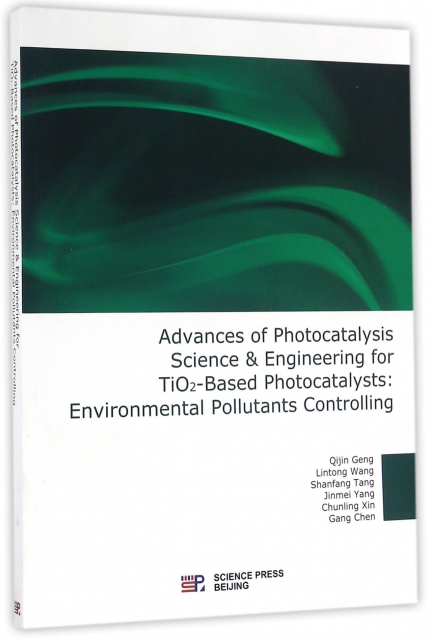| | | | TiO2基光催化在環境污染治理領域的研究進展(英文版) | | 該商品所屬分類:工業技術 -> 環境科學 | | 【市場價】 | 1430-2073元 | | 【優惠價】 | 894-1296元 | | 【介質】 | book | | 【ISBN】 | 9787030498298 | | 【折扣說明】 | 一次購物滿999元台幣免運費+贈品
一次購物滿2000元台幣95折+免運費+贈品
一次購物滿3000元台幣92折+免運費+贈品
一次購物滿4000元台幣88折+免運費+贈品
| | 【本期贈品】 | ①優質無紡布環保袋,做工棒!②品牌簽字筆 ③品牌手帕紙巾
|
|
| 版本 | 正版全新電子版PDF檔 | | 您已选择: | 正版全新 | 溫馨提示:如果有多種選項,請先選擇再點擊加入購物車。*. 電子圖書價格是0.69折,例如了得網價格是100元,電子書pdf的價格則是69元。
*. 購買電子書不支持貨到付款,購買時選擇atm或者超商、PayPal付款。付款後1-24小時內通過郵件傳輸給您。
*. 如果收到的電子書不滿意,可以聯絡我們退款。謝謝。 | | | |
| | 內容介紹 | |

-
出版社:科學
-
ISBN:9787030498298
-
作者:Qijin Geng//Lintong Wang//S...
-
頁數:304
-
出版日期:2016-01-01
-
印刷日期:2016-01-01
-
包裝:平裝
-
開本:16開
-
版次:1
-
印次:1
-
Qijin Geng、Lintong Wang、Shanfang Tang
、Jinmei Yang、Chunling Xin所著的《TiO2基光催
化在環境污染治理領域的研究進展(英文版)》針對光
催化劑的發展和在環境污染治理方面的應用研究,做
了繫統總結和整理,概括為以下幾個內容:(1)光
催化劑表面結構與性能研究進展;(2)光催化科學
基礎理論的研究進展;(3)光催化技術在大氣污染
治理方面的研究進展;(4)光催化技術在水污染治
理方面的研究進展。
-
Foreword
1 Progress of Photocatalysis Science and Technology
Introduction
1.1 A brief overview ofphotocatalysis
1.2 Photocatalytic reactor design and application in air and waste water treatments
1.2.1 Photon transfer limitations and overcoming measurements
1.2.2 Mass transfer limitations and overcoming measurements
1.2.3 Other engineering problems in reactor design
1.3 Future prospects
2 Fundamentals of Photocatalysis
Introduction
2.1 Photocatalysis mechanism
2.1.1 Reductive mechanism
2.1.2 Oxidative mechanism
2.1.3 Combined redox mechanism
2.2 Photoelectrochemical basis ofphotocatalysis
2.3 Time scales for primary processes
2.4 Trapping of electrons and holes
2.5 Factors affecting electron transfer efficiency
2.6 Oxidizing species at the TiO2 surface
2.6.1 Role of molecular oxygen
2.6.2 Effect of crystal face
2.7 Relation between interfacial electron transfer rate constants and driving force
2.8 Summary
3 Heterogeneous Photoeatalytie Degradation of Waste Water Containing Phenolic Compounds
Introduction
3.1 Fundamentals of photocatalysis of phenols
3.1.1 Basic mechanism
3.1.2 Performance of phenol, chlorophenol and nitrophenol in photocatalysis
3.1.3 Phenol and its intermediates formed and detected
3.1.4 Pathways of phenol photodegradation
3.1.5 Kinetic model for phenol photodegradation
3.2 Reyiew ofphotocatalytic oxidation of phenolic compounds
3.3 Influencing factors on photocatalytic oxidation of phenolic compounds
3.3.1 Substituted group of phenolic compounds
3.3.2 Structure property and composition ofphotocatalyst
3.3.3 Light intensity and wavelength
3.3.4 Initial concentration of phenolic compounds
3.3.5 Photocatalyst loading
3.3.6 Medium pH value
3.3.7 Co-existing substances
3.3.8 Oxidants/electron acceptor added
3.3.9 Calcination temperature ofphotocatalyst
3.3.10 Dopant on photocatalyst
3.4 Conclusion and outlooks
4 Heterogeneous Photocatalytic Degradation of Waste Water Containing Dyes Introduction
4.1 Introduction of dyes
4.2 Experimental techniques applied in photocatalytic degradation of dye
4.3 Mechanisms and pathways ofphotocatalysis
4.3.1 Basic mechanism
4.3.2 Possible pathways
4.3.3 Interaction mechanism between dye molecule and inorganic ion
4.3.4 Basic models of photocatalyses and pathways
4.4 Operational factors influencing on the photocatalytic degradation of dyes
4.4.1 Dye concentration
4.4.2 Catalyst amount
4.4.3 pH value
4.4.4 Oxidizing agent
4.4.5 Light intensity and irradiation time
4.4.6 Dissolved oxygen
4.4.7 Doped photocatalyst
4.4.8 Dopant content
4.4.9 Calcination temperature ofphotocatalyst
4.4.10 Dye structure
4.4.11 Molecular size of the dyes
4.4.12 Inorganic ions added
4.5 Conclusions and prospect
5 Heterogeneous Photocatalytic Removal of Inorganic Ions From Waste Water Introduction
5.1 Fundamentals of As photocatalytic removal
5.1.1 States of inorganic and organic arsenic
5.1.2 Basic mechanisms of arsenic removal
5.2 Review of photooxidation of As(HI) and organic arsenic
5.2.1 Initial works and recent research advances
5.2.2 Modified photocatalyst to enhance arsenic removal
5.3 Influencing factors for photocatalytic oxidation of As
5.3.1 Co-existing solutes
5.3.2 pH value
5.3.3 Photocatalyst size
5.4 Conclusions and future challenges
5.5 Review of photocatalytic removal of Cr
5.5.1 Supported TiO2
5.5.2 Doped TiO2
5.6 Basic mechanism for photocatalytic removal of Cr(Ⅵ)
5.6.1 Mechanism of Fe(Ⅱ)/TiO2 spherical shells
5.6.2 Synergistic mechanism ofphotocatalysis and adsorption on simultaneous removal of Cr(Ⅵ) and Cr(Ⅲ) with TiOE/TNTs
5.6.3 Synergy mechanism of the simultaneous decontamination of phenol and CrⅥ)
5.7 Influencing factors for photocatalytic oxidation of Cr
5.7.1 pH value
5.7.2 Amount ofphotocatalyst
5.7.3 Illumination intensity
5.7.4 Cr (Ⅵ) concentration
5.7.5 Electrolyte
5.7.6 Organic compounds co-existed
5.7.7 O2
5.8 Conclusions and outlook
6 Heterogeneous Photocatalytie Degradation of Gaseous Pollutants Introduction
6.1 Photocatalytic oxidation mechanism
6.1.1 Aliphatic oxidation
6.1.2 Aromatic oxidation
6.2 Progress on the PCO of VOCs and NOx, SO2
6.3 Influencing factors
6.3.1 Light intensity and light spectrum
6.3.2 Pollutant concentration
6.3.3 Humidity
6.3.4 Temperature
6.3.5 Oxygen in photocatalytic system
6.3.6 Additions
6.3.7 Mass transport
6.3.8 Photocatalysts
6.4 Kinetic models
6.5 Summary and future trends
Main References
| | |
| | | | |
|




